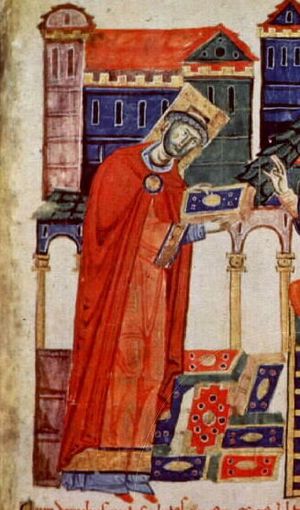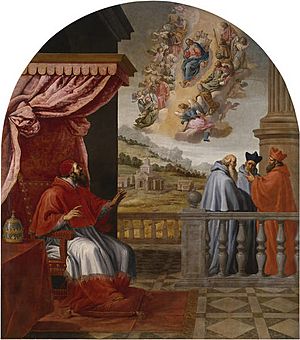Pope Victor III facts for kids
Quick facts for kids Pope Blessed Victor III |
|
|---|---|
| Bishop of Rome | |

Desiderius of Montecassino in a contemporary manuscript
|
|
| Church | Catholic Church |
| Papacy began | 24 May 1086 |
| Papacy ended | 16 September 1087 |
| Predecessor | Gregory VII |
| Successor | Urban II |
| Orders | |
| Consecration | 9 May 1087 by Otho de Lagery |
| Created Cardinal | 6 March 1058 |
| Personal details | |
| Birth name | Dauferio |
| Born | c. 1026 Benevento, Duchy of Benevento |
| Died | 16 September 1087 (aged c. 61) Monte Cassino, Papal States, Holy Roman Empire |
| Previous post |
|
| Sainthood | |
| Feast day |
|
| Venerated in | Catholic Church |
| Beatified | 23 July 1887 Rome, Kingdom of Italy by Pope Leo XIII |
| Attributes |
|
| Patronage | |
| Other Popes named Victor | |
Pope Victor III (born around 1026 – died 16 September 1087) was the leader of the Catholic Church. He was also the ruler of the Papal States from May 24, 1086, until his death. He followed Pope Gregory VII as Pope. However, he is more famous for his time as Desiderius, the important abbot of Montecassino.
He was very sick, which made him not want to become Pope. His health was so bad that he fell ill during his coronation ceremony. The only book he wrote that we still have is called "Dialogues." It tells stories about the amazing things done by Benedict of Nursia and other saints at Montecassino.
Pope Leo XIII declared him "Blessed" on July 23, 1887.
Contents
Early Life and Monastic Journey
Daufer was born around the year 1026. He was allowed to join a monastery called S. Sophia in Benevento.
Life at S. Sophia was not strict enough for young Daufer. He first moved to the island monastery of Tremite San Nicolo in the Adriatic Sea. Then, in 1053, he went to live with hermits (people who live alone for religious reasons) in Majella. Around this time, Pope Leo IX noticed him. The Pope likely asked him to help make peace with the Normans after the battle of Civitate.
Later, Desiderius joined the court of Pope Victor II in Florence. There, he met two monks from the famous Benedictine monastery of Monte Cassino. He went back with them in 1055 and joined their community. Soon after, he became the leader of a smaller monastery in Capua.
Becoming Abbot of Monte Cassino
In 1057, Pope Stephen IX, who was also the abbot of Monte Cassino, visited the monastery. At Christmas, thinking he was dying, he told the monks to choose a new abbot. They chose Desiderius. The Pope got better and wanted to remain abbot. So, he made Desiderius his special representative, or legate, for Constantinople.
Desiderius was in Bari, about to sail for the East, when he heard that Pope Stephen had died. He got a safe pass from Robert Guiscard, a Norman leader. Desiderius then returned to Monte Cassino. He was officially made abbot on Easter Day in 1058.
Pope Nicholas II made him a cardinal on March 6, 1058. He became the Cardinal-Deacon of Santi Sergio e Bacco. In 1059, he chose to become the Cardinal-Priest of Santa Cecilia.
Rebuilding Monte Cassino
As abbot, Desiderius rebuilt the church and other buildings at Monte Cassino. He also improved the scriptorium, which was a place where monks copied books. He brought back strict rules for the monks. Because of his efforts, there were 200 monks in the monastery during his time.
On October 1, 1071, the new church at Monte Cassino was blessed by Pope Alexander II. Desiderius's good reputation brought many gifts and special permissions to the abbey. The money was used for beautiful church decorations. These included a large golden altar front from Constantinople, decorated with jewels and enamels.
Peter the Deacon listed about seventy books that Desiderius had copied at Monte Cassino. These included important works by thinkers like Augustine of Hippo and Jerome. They also copied histories and works by famous Roman writers like Virgil and Cicero.
His Influence and Role in the Church
Desiderius was also made a special representative for the Pope in southern Italy. He had special powers to help improve monasteries. He was so respected by the Pope that he could even choose bishops and abbots for churches and monasteries that needed leaders.
Two years after the Monte Cassino church was blessed, Pope Alexander II died. Pope Gregory VII became the new Pope. Desiderius was able to get help from the Normans (people from southern Italy with Viking roots) many times to support the Pope.
In 1059, he had already convinced Norman leaders like Robert Guiscard to promise loyalty to the Pope. After Gregory VII became Pope, he immediately asked Desiderius for help. Desiderius helped arrange a meeting between Pope Gregory and Robert Guiscard in 1073. He also helped make peace between Norman princes in 1074 and 1075. Even when the Normans were fighting the Pope, they still had good relations with Monte Cassino.
In 1080, Desiderius got Norman troops to help Pope Gregory. In 1082, he visited the future Holy Roman Emperor Henry IV. In 1083, Desiderius tried to help Pope Gregory and Emperor Henry make peace. In 1084, when Rome was controlled by Emperor Henry, Desiderius told both the Emperor and the Pope that Robert Guiscard's army was coming.
Becoming Pope Victor III
Desiderius supported the reforms of Pope Gregory VII. However, he was more moderate and sometimes disagreed with Gregory's strong actions. Still, when Pope Gregory VII was dying in 1085, he suggested Desiderius as one of the best people to become the next Pope.
The people of Rome had forced the Antipope Clement III out of the city. Desiderius hurried to Rome to talk with the cardinals about choosing a new Pope. But when he realized they wanted to make him Pope, he ran away to Monte Cassino. There, he encouraged the Normans and Lombards to support the Pope.
When autumn came, Desiderius went with the Norman army to Rome. But he knew the cardinals and Norman leaders planned to force him to become Pope. So, he refused to enter Rome unless they promised to stop their plan. They refused, and the election was delayed.
Around Easter, the bishops and cardinals in Rome asked Desiderius and the cardinals with him at Monte Cassino to come to Rome to discuss the election. On May 23, a big meeting was held. Desiderius was again asked to accept the papacy, but he kept saying no. He even threatened to go back to his monastery if they forced him.
The next day, May 24, the same thing happened early in the morning. A Roman leader suggested choosing Odo, a cardinal. But some cardinals said this was against church law.
Finally, Cardinal Desiderius, the abbot of Monte Cassino, was chosen as the successor to Gregory VII on May 24, 1086. He took the name Victor III. Four days later, the Pope and cardinals had to run away from Rome because of the Emperor's representative. In Terracina, Victor put aside the papal symbols and went back to Monte Cassino. He stayed there for almost a year.
In early 1087, the Pope-elect attended a meeting of cardinals and bishops in Capua. Here, Victor finally agreed to become Pope. He officially accepted the role.
His Short Papacy
Victor III was elected on May 24, 1086. But his official blessing and crowning didn't happen until March 21, 1087. This was because the Antipope Clement III was in Rome.
After celebrating Easter at his monastery, Victor went to Rome. The Normans drove the soldiers of the Antipope Clement III out of St. Peter's. Victor was then blessed and officially took his place on March 21, 1087. He stayed in Rome for only eight days. Then he returned to Monte Cassino. With help from Matilda and Jordan, he did manage to take back the Vatican Hill.
Before May ended, he was back in Rome because Countess Matilda of Tuscany called him. Her troops held parts of Rome. By the end of June, Clement III took control of St. Peter's again. Victor immediately went back to his Monte Cassino abbey.
Synod and Death
In August 1087, a church meeting called a synod was held in Benevento. At this meeting, they again officially removed the Antipope Clement III from the church. They also called for a crusade (a religious war) against the Saracens in northern Africa.
After three days, Victor became very sick. He went back to Monte Cassino to die. He was carried into the chapter-house (a meeting room in the abbey). There, he made some decisions for the abbey. He also chose the prior, Cardinal Oderisius, to be the next abbot. He then suggested Odo of Ostia to the cardinals and bishops as the next Pope.
Pope Victor III died on September 16, 1087. He was buried in the tomb he had prepared for himself in the abbey's chapter-house. Odo was later chosen as his successor, becoming Pope Urban II.
Writings
Pope Victor's only book that still exists is called Dialogues. It tells stories about the amazing things done by Benedict and other saints at Monte Cassino.
Peter the Deacon, a writer from Monte Cassino, also said that Victor wrote a song and letters to King Philip I of France and to Hugh of Cluny. However, these writings no longer exist.
Posthumous Legacy

People started honoring Blessed Victor III not long after his death, around the time of Pope Anastasius IV. In 1515, Victor III's body was moved to the main abbey church in Monte Cassino. Many pilgrims visited his tomb.
In 1727, the abbot of Monte Cassino received permission from Pope Benedict XIII to celebrate his feast day. Pope Leo XIII declared Victor III "Blessed" in 1887. At that time, his body was moved again to the Chapel of St. Victor.
During World War II, his body was moved to Rome to keep it safe. The main abbey at Monte Cassino was destroyed in February 1944 by US bombing. Victor's body was moved back to the rebuilt abbey in 1963.
See also
 In Spanish: Víctor III para niños
In Spanish: Víctor III para niños

